Seed germination is a crucial step in gardening, and mastering this process can lead to successful and abundant plant growth. This blog will explore various proven techniques to enhance seed germination rates, whether you’re growing vegetables, flowers, fruits, or herbs. From providing the right environmental conditions to using effective methods, we’ve got you covered to ensure your seeds sprout faster and flourish into healthy, thriving plants.
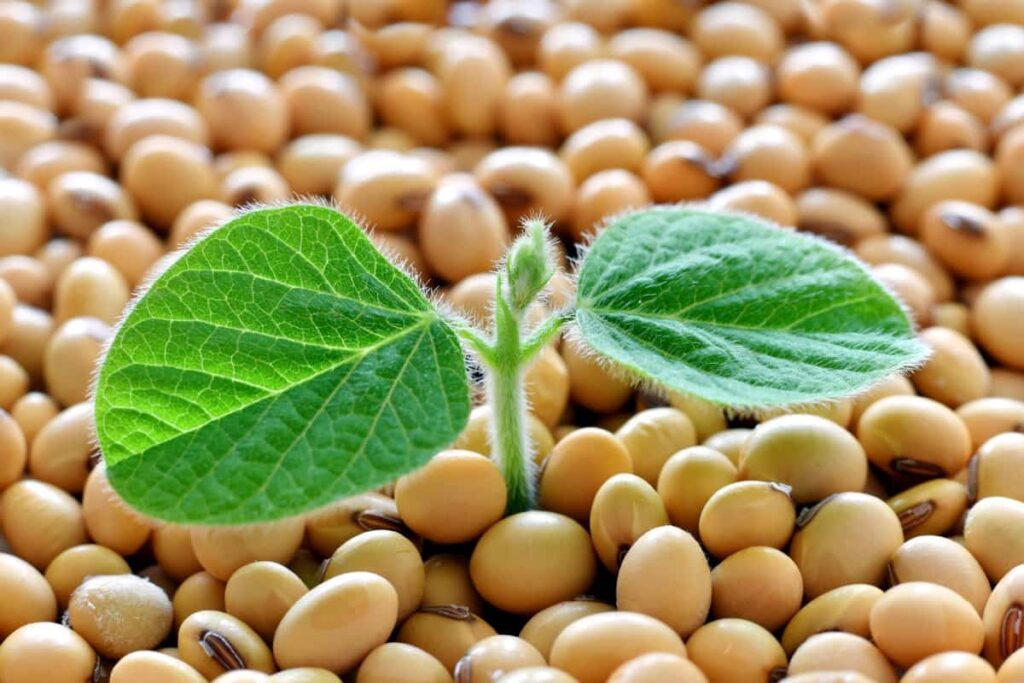
What is Seed Germination?
Seed germination, commonly known as seed starting, is a fundamental process in gardening where plants are grown from seeds rather than pre-grown plants bought from stores. This method involves initiating the growth of seeds indoors, leading to the birth of a new plant. Starting seeds indoors has multiple advantages: it enhances germination rates and allows better control over the young plants’ development.
When seeds are sown outside, they encounter diverse environmental conditions, which can reduce their chances of survival. Conversely, indoor germination provides a more controlled and nurturing environment, increasing the likelihood of successful plant growth. Gardeners opt for this technique to ensure better plant health and vitality.
Understanding the Seed Germination Process
Seed germination indoors offers benefits, especially for slow-growing plants and those sensitive to cold weather. While not all seeds require indoor starting, it provides a head start for the growing season and extends the time for tender plants to mature in cooler temperatures. For instance, green beans typically don’t need indoor germination due to their short maturity period of 50-60 days.
Still, plants like tomatoes, peppers, watermelons, pumpkins, and herbs benefit from extra care and early growth indoors. Seeds’ germination duration varies based on factors like soil and air temperatures. Higher temperatures around 70 degrees Fahrenheit generally lead to faster germination. Gardeners can refer to a seed germination rate chart to understand each vegetable’s approximate time to sprout under optimal conditions.
In case you missed it: Optimizing Coconut Orchard Operations: A Comprehensive Management Guide for Month-wise Planning
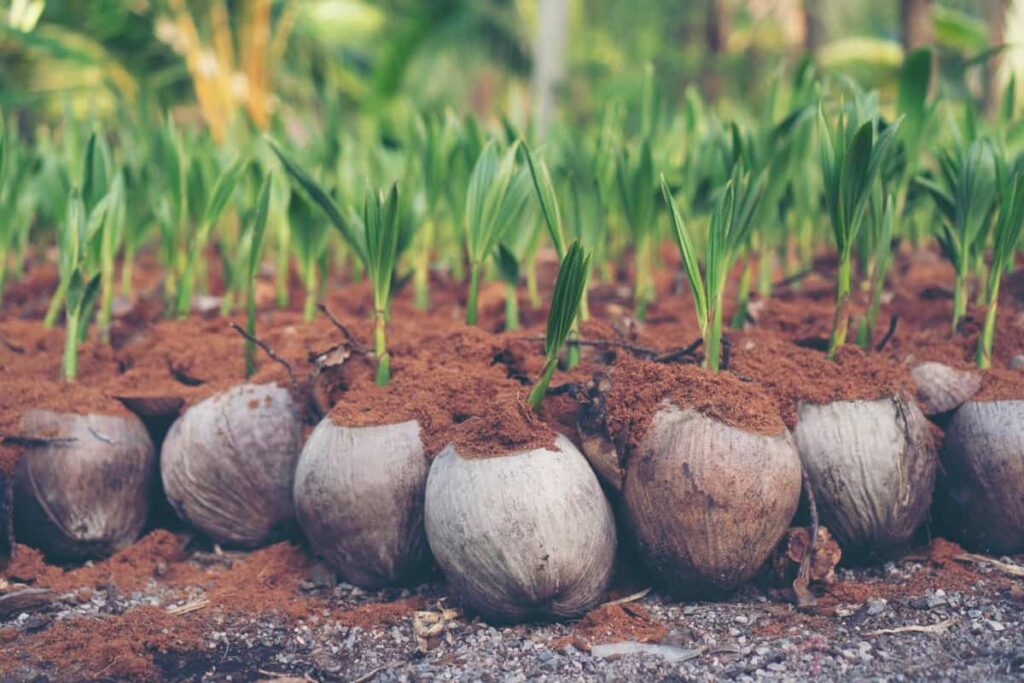
How to Germinate Seeds for Vegetables, Flowers, Fruits, and Herbs
- Prepare a sterile seed starter mix or use commercially available ones to minimize the risk of bacteria interfering with germination.
- Utilize trays, seedling cups, peat pots, or styrofoam cups as containers.
- Dampen the soil before planting the seeds, ensuring it holds water for germination.
Create greenhouse effect by covering the trays to increase humidity, a vital factor for high germination rates. Keep the seeds warm at around 70 degrees Fahrenheit, using grow lights or heat mats if necessary. Consistent moisture is crucial for germination; use a spray bottle to moist soil but avoid overwatering. To accelerate germination, try four effective tricks:
- Germinate seeds on paper towels in a closed container away from direct sunlight.
- Pre-soak seeds for 24 hours before planting to encourage faster emergence.
- Employ cold treatment (stratification) for certain seeds by keeping them in a moist medium in the refrigerator before transferring them to pots or outdoor planting.
- Use scarification or nicking the seed’s coat with a knife or sandpaper to fasten germination by allowing moisture to reach the embryo.
Key Factors in Seed Germination for Vegetables, Flowers, Fruits, and Herbs
Moisture
- Adequate moisture is crucial during germination and seedling growth.
- Most species require consistently moist conditions until the radicle emerges.
- Gradually allow the media to dry out between waterings as seedlings grow.
Water Quality
- Avoid using water treated with a softener, as it may contain harmful salts.
- Chlorinated water can be left in an open container overnight to remove chlorine.
- Use lukewarm water to avoid stressing seedlings; cold water can be detrimental.
Water Application
- Water gently, especially with small seeds, to avoid disturbing their placement.
- Use a fine mist nozzle or water from the bottom of the tray.
- Do not leave the tray in water after it becomes moist; it can reduce oxygen levels.
In case you missed it: How to Grow Alfalfa Microgreens from Seed: A Step-by-Step Seed Germination Guide
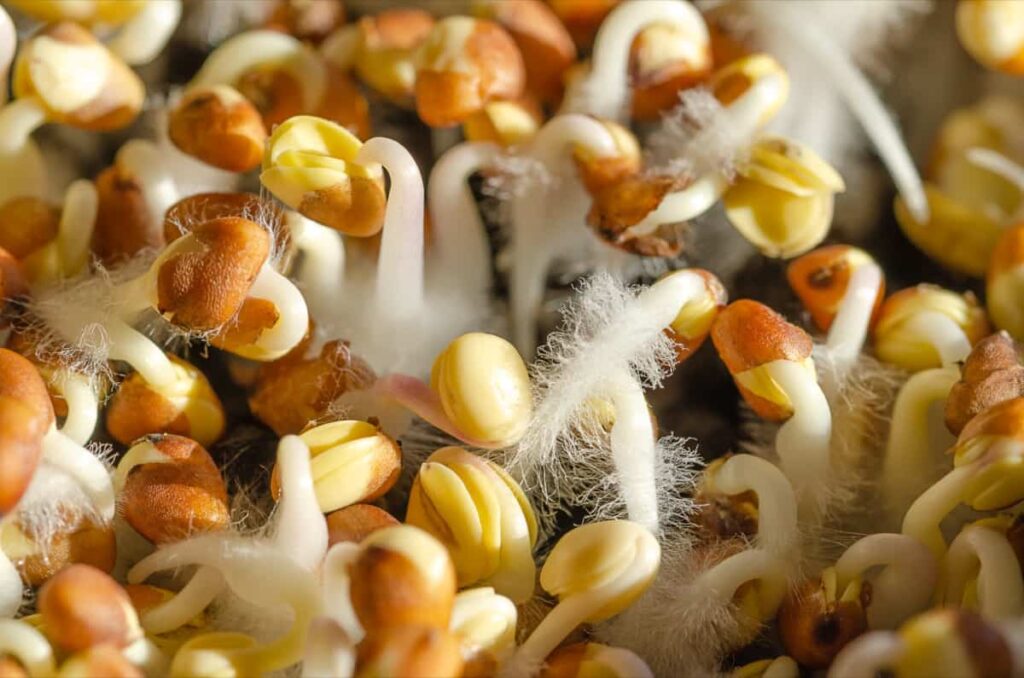
Temperature
- Temperature influences the germination rate, with each species having an optimal range.
- Germination is generally fastest within the optimal temperature range.
- Low and high temperatures can reduce seed germination, and cool temperatures slow it down.
Providing Optimal Temperature
- Most annual flower and vegetable seeds germinate well at around 70 to 75°F.
- Consistent temperatures within the optimal range promote uniform germination.
- Using a thermostatically controlled seedling heat mat ensures the ideal temperature for germination.
Alternating Temperatures
- Some plants prefer cooler nights to day temperatures by 5 to 10°F.
- Options for alternating temperatures include sowing outdoors or using a timer on a seedling heat mat.
Selecting High-quality Seeds for Germination
Selecting high-quality seeds for germination for successful gardening, whether vegetables, flowers, fruits, or herbs. Look for seeds from reputable suppliers or certified packets with high germination rates. Fresh seeds have better viability and sprouting potential compared to old ones. For instance, tomato seeds with high viability can show germination rates of over 80%.
Choosing from reliable sources ensures the seeds are free from contaminants and disease. Seeds that have undergone quality testing and storage under proper conditions have higher chances of successful germination. Opt for hybrid or open-pollinated seeds, depending on your gardening preferences. Hybrid seeds offer improved traits like disease resistance, while open-pollinated seeds preserve genetic diversity.
Preparing the Ideal Germination Environment
To ensure successful seed Germination of vegetables, flowers, fruits, and herbs, create an ideal germination environment using a sterile mix, clean containers with proper drainage, clear trays with clear covers, adequate light, warmth, and air circulation, maintain the germination area at the optimal temperature range, and maintain consistent moisture levels without overwatering. Examples of vegetables, flowers, fruits, and herbs that benefit from an ideal germination environment include tomatoes, petunias, watermelons, and basil.
Providing Adequate Moisture for Seed Germination
Providing adequate moisture is critical in successful seed germination for various vegetables, flowers, fruits, and herbs. During germination and seedling growth, seeds require consistent moisture to initiate sprouting. However, avoiding overwatering is essential, as excessive moisture cause damping off and other fungal diseases. To ensure proper moisture levels, dampen the seed starting mix before planting the seeds. Use a spray bottle to water gently and evenly, avoiding disturbance to seed placement.
In case you missed it: How to Grow Jalapeno Peppers from Seed: A Step-by-Step Guide for Types, Seed Germination, and Planting
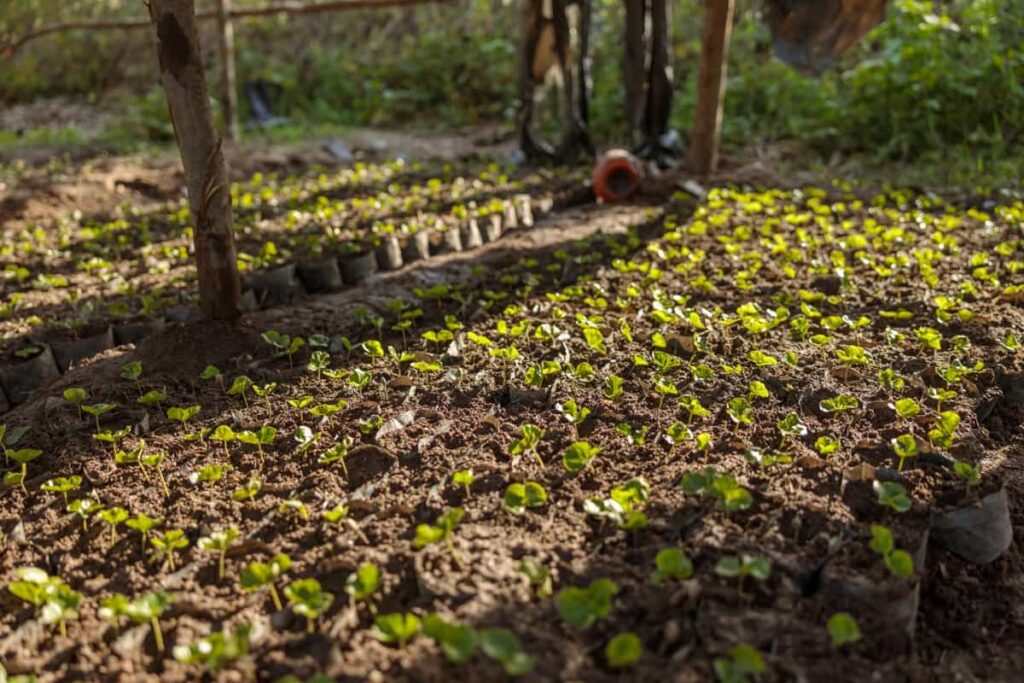
As seedlings grow, they become more tolerant of fluctuating moisture levels, but the media should be allowed to dry out slightly between waterings. For example, lettuce seeds (Lactuca sativa) need consistent moisture to germinate, with the ideal soil temperature range of 70-75°F. Lettuce seeds germinate within 7-10 days under proper moisture conditions. Similarly, tomato seeds (Solanum lycopersicum) require adequate moisture and temperatures around 70-80°F for optimal germination, typically within 5-7 days.
Utilizing Proper Temperature Conditions
Proper temperature conditions are needed for germinating seeds for vegetables, flowers, fruits, and herbs. Different plant species have specific temperature requirements for optimal germination rates. Here are some examples:
- Tomatoes (Solanum lycopersicum): Tomatoes prefer a warm germination environment, with an optimal temperature range of 70 to 85°F (21 to 29°C).
- Lettuce (Lactuca sativa): Lettuce seeds germinate well in cooler temperatures, with an optimal range of 60 to 70°F (15 to 21°C).
- Peppers (Capsicum annuum): Peppers require warmth for germination and grow best at temperatures between 75 to 85°F (24 to 29°C).
- Basil (Ocimum basilicum): Basil seeds germinate best at temperatures around 70 to 75°F (21 to 24°C).
- Watermelon (Citrullus lanatus): Watermelon seeds thrive in warm conditions, with an optimal temperature range of 80 to 90°F (27 to 32°C).
- Marigold (Tagetes spp.): Marigold seeds prefer a moderately warm environment, with an optimal temperature range of 70 to 75°F (21 to 24°C).
Maintaining consistent temperatures within the optimal range is crucial to ensure uniform germination and healthy seedling development. A thermostatically controlled seedling heat mat can provide the ideal temperature conditions for each specific plant species.
Enhancing Germination with Stratification
Stratification is a seed treatment method to enhance germination for various plants, including vegetables, flowers, fruits, and herbs. It involves subjecting seeds to cold and moist conditions, mimicking the natural winter conditions they would experience in their native habitats. This process is especially beneficial for seeds from cold climates that require specific cues, like exposure to winter temperatures, to break dormancy and initiate germination.
For example, many wildflowers, such as Lupinus perennis (wild lupine), and some fruit trees, like Malus domestica (apple tree), require stratification to improve germination rates. The cold stratification process helps break down seed coat dormancy and encourages the embryo to grow once favorable conditions return in spring.
Gardeners can achieve stratification by placing seeds in a moist medium, like damp sand or peat moss, and storing them in a cool environment, such as a refrigerator, for a specific period. This treatment stimulates the seeds to prepare for germination, ensuring better success when planted in the spring or in suitable growing conditions.
In case you missed it: Seed Germination Chart in India: Duration and Temperature for Fruits, Vegetables, Flowers, and Herbs
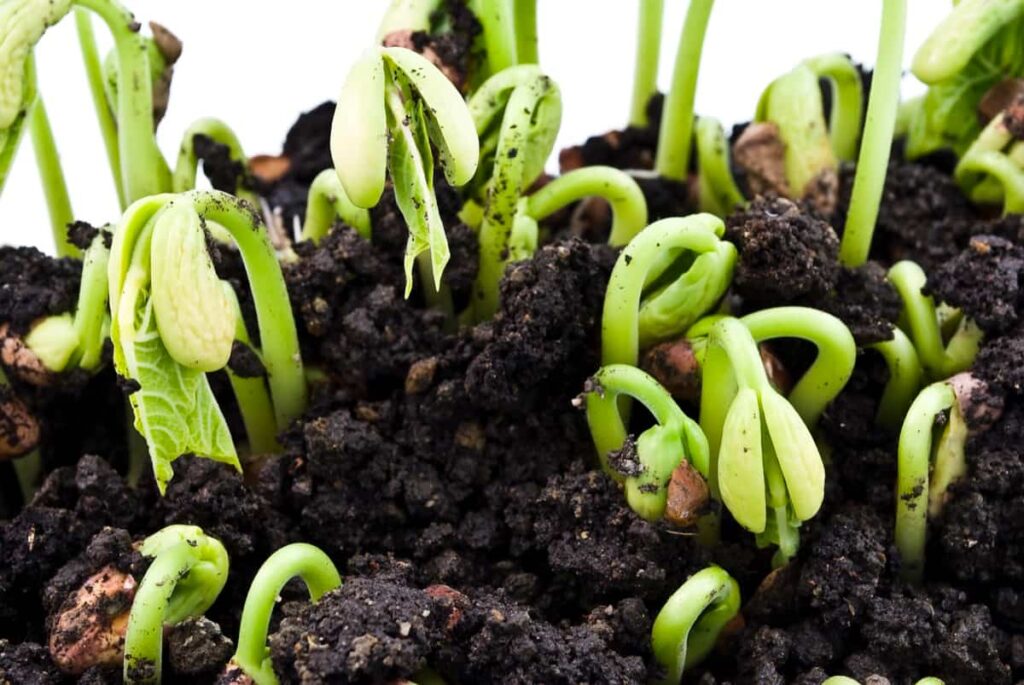
Scarification Techniques for Hard Seed Coats
Scarification is a seed treatment technique that enhances germination in seeds with hard coats. This process involves nicking, scratching, or weakening the seed coat, which water to penetrate and trigger germination. Scarification can particularly benefit certain vegetables, flowers, fruits, and herbs with naturally resistant seed coats. Examples of seeds that can benefit from scarification include:
- Morning Glory (Ipomoea spp.).
- Scarlet runner beans (Phaseolus coccineus).
- Some types of sweet peas (Lathyrus spp.).
These seeds have tough outer layers that can inhibit water absorption and prevent germination. You can use sandpaper or a small file to gently rub the seed coat or make a small nick with a sharp knife to scarify seeds. Be cautious not to damage the embryo inside the seed during the scarification process. After scarification, soak the seeds in water to encourage swelling and germination.
Soaking Seeds to Promote Germination
Soaking seeds to promote germination benefits various vegetables, flowers, fruits, and herbs. The process involves pre-soaking seeds in water to kickstart the germination process. Scientifically, soaking seeds hydrates the embryo and softens the seed coat by allowing water to penetrate and activating enzymes necessary for germination. Seeds that benefit from soaking include beans, peas, sunflowers, and morning glories. Soaking times can vary, but 12 to 24 hours is generally sufficient. After soaking, plant the seeds immediately in a well-draining seed starting mix.
Using Seed Priming to Expedite Germination
Seed priming is a technique that expedites germination for vegetables, flowers, fruits, and herbs. It involves hydrating seeds to the point of initial germination and then drying them before planting. This process activates the seed’s metabolic activities and triggers germination faster than traditional methods.
Scientific studies have shown that seed priming significantly improves germination percentage and reduces the time required for seeds to sprout. For example, research on priming lettuce seeds demonstrated a 10-30% increase in germination rates and a 20-50% reduction in germination time compared to non-primed seeds.
Employing Bottom Heat for Faster Germination
This method stimulates root growth and enhances seedling development. Scientifically, warmer soil temperatures promote enzymatic activity and metabolic processes crucial for germination. For instance, tomato seeds require soil temperatures between 75-85°F (24-29°C) for faster germination. Bottom heat can be achieved using seedling heat mats or cables placed beneath the seed trays. This technique accelerates germination, leading to quicker sprouting and healthier seedlings for vegetables, flowers, fruits, and herbs in your garden.
Employing Grow Lights, Air Circulation, and Avoiding Overwatering for Optimal Germination
Grow Lights: Grow lights provide essential light to seeds, especially in indoor settings or low-light areas. They mimic natural sunlight, promoting robust seedling growth. LED or fluorescent grow lights are popular choices. For example, tomato seeds require adequate light for germination, and with proper exposure to grow lights, they exhibit faster and healthier growth.
In case you missed it: Vegetable Growing Season Chart in India: Sowing Guide, Germination and Planting Calendar
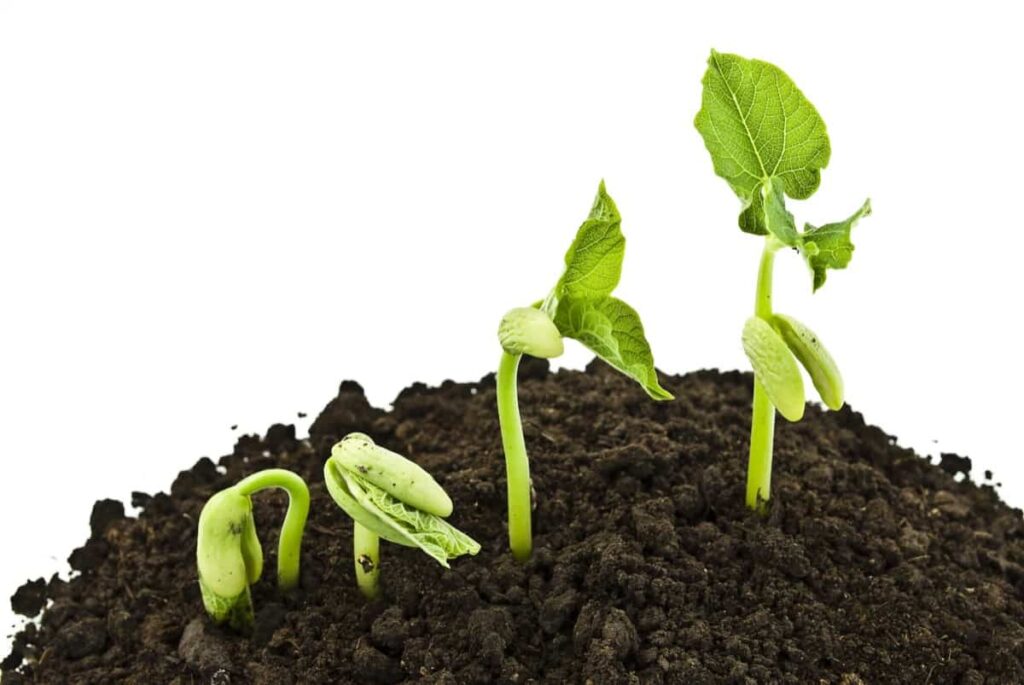
Air Circulation: Good air circulation prevents fungal diseases and ensures sufficient oxygen for seedlings. A fan or ventilation system can enhance air movement. For instance, herbs like basil thrive with adequate air circulation, reducing the risk of damping-off disease.
Avoiding Overwatering: Overwatering leads to root rot and poor germination rates. Provide consistent moisture without saturating the soil. For example, lettuce seeds prefer well-drained soil, and overwatering can hinder germination.
Troubleshooting Common Issues in Seed Germination
To ensure successful seedling germination, check seed quality, use fresh, high-quality seeds, and verify the germination environment. Consider using seed priming techniques to expedite germination. Avoid damping off, use sterilized seed starting mix and containers, and avoid overwatering. Monitor pH levels and adjust as needed to optimize nutrient availability. Use a balanced seed starting mix with essential nutrients for healthy germination.
Maintain consistent temperature conditions within the optimal range for chosen seeds and consider using a thermostatically controlled seedling heat mat. Inspect seedlings for pests or diseases and address issues promptly. Use sterile containers and potting mix to minimize the risk of introducing pathogens. Follow the seed packet instructions for planting depth to ensure proper emergence and germination.
Conclusion
Mastering seed germination techniques is essential for successful gardening. By providing the right environment, moisture, and temperature and employing strategic methods like stratification and scarification, gardeners can ensure faster and more efficient seed germination for a flourishing and diverse garden.
- Aquaponic Farming at Home: A Step-By-Step Guide
- Profitable Village Farming Business Ideas in 2024
- High-Yield Aquaculture: Fast-Growing Fish for Farming
- Effective Fish Pond Construction Techniques for Beginners
- Irrigation and Water Management in Pineapple Farming
- Blossom to Harvest: Mastering Flowering and Pollination in Papaya Farming
- Pig Fattening Essentials: From Selection to Sale for Beginners
- Raising Wagyu Cattle: A Complete Guide for Premium Beef Production
- Soil Types and Their Water Holding Capacity
- Optimizing Irrigation Schedules for Coconut Groves for Enhanced Yield
- Espresso Your Garden: Coffee Grounds for Healthier Acid-Loving Plants
- The Best Soil Mix for Snake Plants: How to Mix Your Own Snake Plant Soil
- Green Thumb Success: Expert Tips for Cultivating Greenhouse Beans All Year Round
- Bloom All Year Round: The Ultimate Guide to Indoor Hyacinth Care
- Eco-Friendly Gardening: How to Make Liquid Fertilizer from Kitchen Waste
- Ultimate Guide to Grow Anise in Pots: Explore Seed Propagation to Harvesting
- Guide to Raising Chester White Pigs: Discover Breed Facts to Growth Management
- Mastering the Elegance: The Ultimate Guide to Weeping Cherry Tree Care, Planting, and Maintenance
- Ultimate Guide to Planting Garlic in Grow Bags: Growing Strategies for Beginners
- How to Fix Spider Plant Leaf-Related Problems: Natural and Organic Remedies
- 10 Reasons Why Your Tulsi Plant is Shedding Leaves: Home Remedies and Solutions
- Optimizing Growth and Yield: The Advantages of Palm Bunch Ash Fertilizer
- Utilizing Neem Oil Extract as a Natural Pesticide for Hydrangea
- From Soil to Harvest: Various Ways in Which Farmers Can Use AI Tools
- Steps to Encourage and Induce Citrus Flowers: A Comprehensive Guide
- How to Fix Snake Plant Leaf-Related Issues: Natural and Organic Remedies
- Transform Your Garden into a Fragrant Oasis with Raat Ki Rani (Night Blooming Jasmine)
- Discover the Ideal Chicken Breeds for Philippine Farms
- How to Create a Poultry Egg Farm Business Plan for Profits
- Grow Lemon Cucumbers Like a Pro: Insider Techniques for Bountiful Yields
- Ultimate Guide to Caring for Your Pink Princess Philodendron: Tips for Thriving Variegation
- Areca Nut Profit Per Acre: Calculating Yield and Cost of Cultivation
- How Kaveri Chicken is Becoming a More Profitable Breed in Indian Backyards
- Transform Your Barn: 9 Steps to Convert a Horse Stall into a Chicken Coop
- Exploring Suffolk Sheep Disadvantages with Limitations and Challenges
- Guide to Solving Potted Lemon Tree Problems: How to Revive Lemon Tree in Containers
